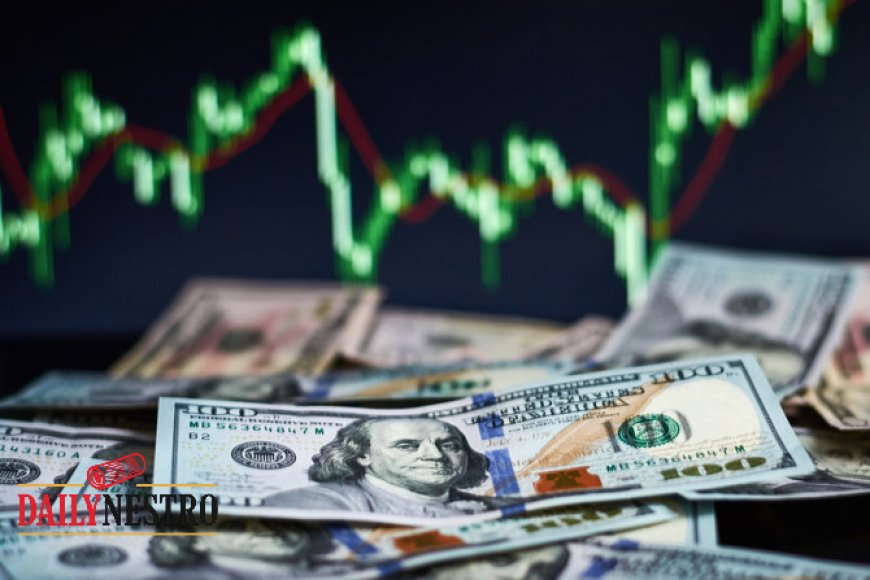Dollar Jumps as Fed Split Over Rates Hits Global Markets
The US Dollar Index (DXY) surges amid mixed Federal Reserve signals and the longest manufacturing slump since the pandemic. Discover how this US turbulence is tightening global liquidity, hiking emerging market debt (Nigeria's $43.6B burden), and reshaping investment strategy.

The U.S. dollar, the world’s most powerful currency, surged to a critical three-month high this week.
This rally isn't a sign of booming confidence but rather a reflection of mounting investor anxiety fueled by two core problems: deep uncertainty over the Federal Reserve’s next move and persistent, troubling weakness in the U.S. manufacturing sector.
Markets are now navigating a bizarre contradiction: key economic data is delayed by a government shutdown, while Fed officials are delivering conflicting messages, confusing investors and driving up volatility.
The Fed’s Communication Breakdown: Waller vs. Williams
Just weeks ago, the market consensus was tilting toward early 2026 rate cuts as inflation appeared to be cooling. That narrative has been shattered by the central bank’s own communication breakdown.
Hawkish Warning: Fed Governor Christopher Waller cautioned that "premature easing could undo hard-won progress," signaling a desire to keep rates high.
Dovish Counterpoint: New York Fed President John Williams countered, hinting that "policy adjustments may soon be appropriate" if inflation continues its moderate path.
This division sent the U.S. dollar index (DXY) climbing 0.8% to 107.1, its peak since late July. This strengthening tightens global liquidity, making everything from mortgages to corporate loans more expensive worldwide.
Manufacturing Contraction: Longest Slump Since Pandemic
Adding to the tension, the S&P Global Manufacturing PMI for October fell to 46.7, marking the eighth consecutive month of contraction, the longest such slump since the pandemic era.
This decline is being driven by:
Trade Frictions: Persistent tariffs on Chinese imports continue to weigh on factory costs and planning.
Weak Foreign Demand: Global economic slowdowns are suppressing orders for U.S. exports.
High Costs: Elevated borrowing costs and input prices are forcing manufacturers to delay vital investment decisions.
Even as companies race to implement AI and automation for productivity gains, the fundamental business environment is described as “severely depressed,” according to industry reports.
Equity Markets: Selective AI Boom Masks Risk
Despite the gloomy manufacturing data and currency strength, the Dow Jones Industrial Average showed surprising resilience, buoyed by the tech sector's AI narrative (Nvidia, Amazon, Broadcom).
However, the selective nature of this boom is apparent: Palantir Technologies saw its stock drop over 6% after missing earnings expectations. This disparity underscores that the AI investment wave is not a universal tide. A stronger dollar now poses an imminent risk, threatening to erode the overseas earnings of U.S. multinationals.
Global Ripples: How Emerging Markets Bear the Cost
For emerging economies, the dollar’s surge is not just financial news; it’s an economic pressure cooker. A stronger greenback translates directly to capital outflows, soaring import costs, and a painful increase in debt servicing burdens.
Nigeria is particularly vulnerable. The renewed strength of the dollar directly complicates efforts to stabilize the naira and control inflation.
Debt Revaluation Shock: Nigeria's external debt reached $43.6 billion in mid-2025. This debt is largely dollar-denominated; every point the DXY rises makes the cost of servicing that debt in Naira significantly higher, stalling monetary reforms.
Inflation Risk: A stronger dollar makes key imports (food, fuel, machinery) more expensive, fueling domestic inflation and jeopardizing the goal of stabilizing price growth below 20%.
The "Higher for Longer" Tightrope
The Fed is walking a tightrope. Hold rates too high, and they risk a deeper growth slump; cut too soon, and they risk a renewed inflation spike. The next critical market catalyst will be the November 13 Consumer Price Index (CPI) data.
The key takeaway for global businesses and investors is clear: the "higher for longer" era is evolving, not coming to an end.
The dollar’s surge is the siren call: the world's financial architecture still revolves around Washington’s policy. For policymakers in Africa and other emerging markets, financial independence must begin with strategic innovation, from deepening local capital markets to leveraging fintech for currency volatility hedging.
The debate in the U.S. is over interest rates; the debate for emerging economies is about economic survival.







